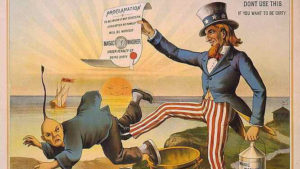Millions of us are appalled by Trump’s Muslim refugee ban. I’m equally appalled that so many of those who claim “a war on Christmas” is proof of religious persecution see no problem with this ban. Yet the fact is there’s a long history of discrimination in American immigration policy. As Savannah Cox recently wrote:
Denying the poor, huddled masses entry into the country has formed the basis of federal immigration acts since their inception. Trump’s ban does not mark a grand departure from American values, but rather presents American values in their ugliest, most blatant and unapologetic form.
Let’s take a stroll down memory lane.
1882 — Congress passes the Chinese Exclusion Act, acceding to cries that “the Chinese are taking jobs away from Americans.” The Act, the first federal restriction on immigration, prohibited “Chinese laborers,” both skilled and unskilled, from entering the country. It also precluded courts from granting citizenship to Chinese resident aliens but they could deport them. The ban was to last 10 years. It was not repealed until 1943.

Washing detergent ad circa 1886
1891 — The Immigration Act of 1891 revised the 1882 Act and increased the categories of excludable aliens, adding, among other things, anyone whose ticket was paid for by another or who was assisted by others.
1911 — A commission created by the Immigration Act of 1907 issued a 41 volume report on immigration. It determined there was a difference between “Old Immigrants” and “New Immigrants.” The former came from northern or western Europe and the latter from southern and eastern Europe. It concluded the New Immigrants posed a serious threat to American society and should be greatly reduced.
1917 — The Immigration Act of 1917 created the “Asiatic Barred Zone.” It excluded people from Eastern Asia, except for Japan and the Philippines. The zone included Afghanistan, Arabia and India. The law also introduced a reading test for all immigrants over 14 years of age.
1921 — A product of the 1911 commission report, the Emergency Quota Act limited immigrants to 357,000 per year. More important, a per country cap was put in place, limiting immigrants from any one country to three percent of the number of its residents living in the United States based on the 1910 Census. Although this was supposed to be a temporary measure, the national origins formula continued until 1965.
1924 — The national origins formula was changed in Immigration Act of 1924. It reduced the per country quotas to two percent of each nationality based on the 1890 Census and completely excluded Asian immigrants. As most immigration from Southern and Eastern Europe occurred after 1890, 87 percent of the entry permits were for Northern Europe, Britain and Ireland. The quotas for Southern and Eastern Europe were so restrictive that in 1924 more of those nationalities left the United States than arrived. Yet even the Northern European quotas had adverse effects. In 1939, the quota for German citizens was 27,370. The year before, some 300,000 Germans — mostly Jewish refugees — applied for U.S. entry permits. As for the complete exclusion of Asians, a 1952 presidential commission on immigration reported a general view that “our discriminatory immigration law was a contributory factor” to Japan’s attack on Pearl Harbor.
Despite this history and the fact our current hodgepodge of immigration laws desperately need comprehensive reform, our immigration system shouldn’t be totally condemned. As noted, 1943 saw the repeal of the Chinese Exclusion Act and nation-of-origin restrictions were abolished in 1965. Additionally, after World War II, the government distinguished refugees from immigrants. The first refugee legislation passed by Congress was the 1948 Displaced Persons Act, which helped victims of Nazi persecution or those who could not return to their country because of persecution based on race, religion or political opinions. Later would come legislation for refugees of Communist regimes and from Southeast Asia. This would eventually culminate in the Refugee Act of 1980, the first time U.S. law gave non-citizens fleeing political and other persecution a right to apply for asylum (although support for it was due in part to a desire to limit the number of Vietnamese refugees who began entering the country after the fall of Saigon in 1975).
While Trump’s attack on refugees echoes dark moments of our history, I believe the outcry and broad opposition that followed are truer reflections of America.
Today, a nation ringed by walls would only imprison itself.
President Barack Obama, September 20, 2016







